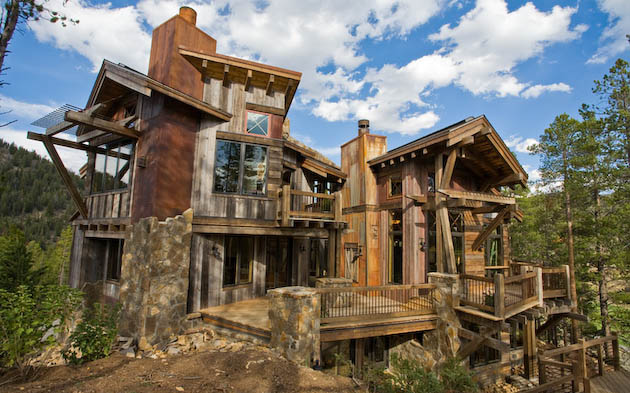
Twin concerns about affordability and energy efficiency are driving the trend in new-home design toward smaller homes, according to industry experts. While prospective homebuyers still want specific amenities in newly constructed homes, such as a family room, a spacious kitchen and an elegant master bath, they also are willing to give up or downsize some rooms for the benefit of a more affordable price.
The National Association of Home Builders (NAHB) survey of homebuilders, designers, architects, manufacturers and marketing specialists, “The New Home in 2015,” reveals that respondents think the average single-family home will shrink to 2,152 square feet in 2015, a decrease of approximately 10 percent from the average single-family home completed in 2010, which is 2,392 square feet.
“To put this in perspective, the peak home size so far was in 2007 at 2,521 square feet,” said Stephen Melman, director of economic services for NAHB. “In 1973, the average new home was 1,660 square feet. The real story is that for the past 35 years, new homes got larger every year, except when they hit a plateau during recessions. The question is whether this time it is different.
“Our members think home sizes will continue to shrink because of energy costs. People want to have a home they can afford and one they can afford to heat.”
Mr. Melman said other factors influencing smaller home sizes include the prevalence in the market of first-time homebuyers, who tend to start with smaller homes, and baby boomers who are becoming empty-nesters needing less space.
While it takes time to design and build new homes, many builders already have introduced smaller model homes as part of their collection of home designs.
“Architects and designers have been careful to keep the elements of a home that matter most to buyers, so while homes are a bit smaller, they are also better designed,” Mr. Melman said. “In some cases, designers are using fewer interior walls, adding more windows and increasing the size of the family room, great room or kitchen in order to meet the lifestyle requirements of buyers. In order to make some spaces larger, they need to eliminate the living room or the fifth bedroom upstairs.”
At K. Hovnanian Homes, new single-family home models are available in some communities with 1,500 to 1,600 square feet, and in some active-adult communities designs start at 1,100 square feet.
“Home sizes depend a lot on the area, and in many places we are still offering large homes because there is demand for them,” said Dee Minich, group senior vice president of sales and marketing for K. Hovnanian Homes. “In some cases, we are offering smaller single-family homes geared to first-time buyers to compete with town homes.”
Ms. Minich said that while some rooms are getting smaller, buyers still want large kitchens, great rooms and family rooms.
“In some of our smaller homes, we have taken out the living room and converted it to a library,” Ms. Minich said. “Some buyers want the option of extending the library and adding an adjacent full bath so that the room can someday be used as a first-floor bedroom.”
Ms. Minich said the space added by eliminating the living room often is used for a bigger kitchen.
“A lot of buyers want the option of expanding the center island in the kitchen because when people entertain, they like having a seating area in the kitchen and extra counter space. Plus, this adds more homework space for the kids.”
At Van Metre Homes, smaller and more energy-efficient homes have been introduced with a living room that buyers can convert into a study rather than having both a living room and study on the first floor.
“We’ve found that buyers don’t want the upkeep or the cost of heating a bigger home,” said Krista Peterson, director of marketing and design center for Van Metre Homes. “We’re using flexible space on the upper level for a retreat for homework or a reading corner with the option of closing it off for a fifth bedroom.”
Ms. Peterson said Van Metre has worked with engineers to design homes that need less wood, which makes the houses more affordable.
“We’ve found that people still want a big kitchen and breakfast area,” Ms. Peterson said. “If we design the breakfast area to be large enough, buyers don’t always need to add an optional morning room.”
Ms. Peterson said buyers still want comfortable rooms and special features working within the constraints of a smaller price tag and less living space.
“Buyers still want a nice master bath, but they are willing to have a larger shower with a smaller garden tub instead of a huge soaking tub,” Ms. Peterson said. “They want to make sure the secondary bedrooms are large enough and that the closets are big enough, too, so they will ask for a smaller upper hall and a smaller master sitting room to have that extra space someplace else.”
Ms. Minich said that in some smaller homes the dining room is shrinking a little because families tend to use their breakfast area or extended morning room for meals.
“In some cases, the homeowners opt to convert the dining room to a library,” Ms. Minich said. “A home office has become important for almost everyone these days because of telecommuting and working after hours. Sometimes both the husband and wife each want a separate office space.”
Ms. Minich said another important feature for most buyers, even with a smaller home, is to have an open area for entertaining, such as a family room or great room open to the kitchen.
The NAHB survey showed that a well-organized laundry room and mudroom is No. 3 on the list of important features for buyers.
“Combining the mudroom and laundry room can be one way to economize on space, but buyers really want functionality in these rooms,” Mr. Melman said.
He said shrinking the foyer and moving stairs to one side can be another way to gain more space for first-floor rooms.
“A first-floor bedroom is fifth on the list of ‘very likely’ features, which is a shift,” Mr. Melman said. “This could be in response to the trend toward multiple generations living together in one home, because a first-floor bedroom offers extra privacy for in-laws, the homeowners or a boomerang adult child. A Pew Research study showed that multigenerational households with at least two generations of adults living together grew to 6.1 percent of all households in 2010, up from 4.8 percent in 2000.”
At Van Metre Homes, every collection of new homes includes at least one design with a first-floor bedroom instead of a living room or study.
“Buyers want flexibility, so many of them opt for a rough-in for a full bath next to the study or on the lower level so they can add bedrooms and baths later,” Ms. Peterson said.
One more trend for new homes is increased energy efficiency.
“Sixty-eight percent of builders say that homes will include more green features, particularly low-E windows, engineered wood and dual-flush toilets,” Mr. Melman said. “The challenge is that everyone wants to be green until it costs too much. The survey showed that if a home costs 5 [percent] to 10 percent more for green features, that is acceptable to buyers, but if the cost is 10 percent or more, they are less likely to choose that house.”
Both Van Metre Homes and K. Hovnanian Homes build all Energy Star-certified homes, in part, because buyers are concerned about reducing their utility bills.
“Buyers expect energy efficiency to be part of the package of buying a new home,” Ms. Minich said. “They want to know they will be comfortable and that they won’t have to overspend on utilities.”
While the homes of the future may be smaller, builders are designing homes to meet the desires of their buyers for flexible rooms, open entertaining spaces and a comfortable kitchen.
Source: washingtontimes.com













